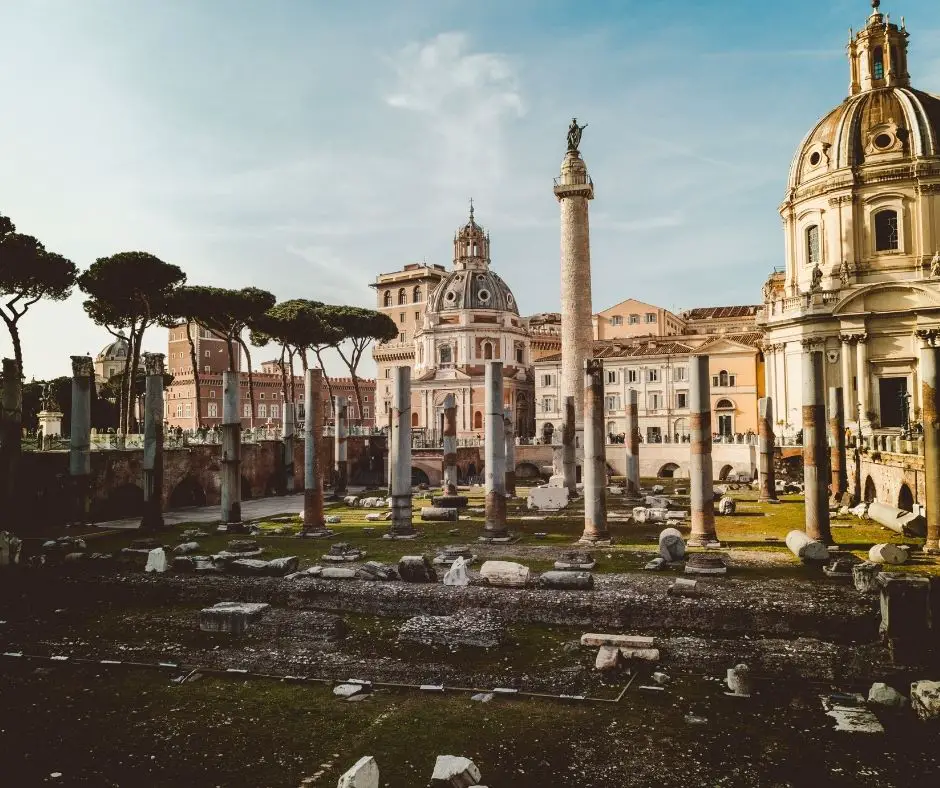Roman Government
The Roman Republic was a political system run by a public representation of the Roman people.
It was a political system run through a representative democracy, with the top magistrates being the two consuls, who had enormous administrative, legislative, judicial, military, and religious authority.
Plenty of the Roman government’s concepts and systems inspired modern democracies.
Ancient Rome had three different types of government:

- Senate
- Consuls
- Assemblies
Ancient Rome History
While the myth of Rome’s origins involves Romulus killing his twin brother Remus to rule Rome and name it after himself, we know that the area was ruled by the Etruscans in the seventh century B.C.
This means that Rome was under the power of a monarchy in its earliest period, which is a system of government that has one ruler. Evidence points to seven different kings ruling Rome at this time.
However, sometime around 509 B.C., the citizens of Rome gained control from the Etruscans and established the Roman Republic. In a republic, the city or country becomes “public” and is no longer property owned or ruled by one person. Officials are elected, and the people all share the leadership.
Early Government
In times of military emergency, Rome appointed a dictator, but he could not hold supreme military command for longer than six months.
The Senate, which advised the Roman people as well as the king, wielded immense power because of its members’ prestige.
During the republic, there were two popular assemblies, the centuriate assembly, and the tribal assembly. The centuriate assembly exercised military power.
Rome received its first written law code in 451 BCE, which became the basis of all subsequent Roman private law.
Roman Republic
The Roman Republic, in many ways, set the standard for the future of many countries. The people began to elect magistrates, who shared power and represented the citizens of Rome.
Two of the magistrates were known as consuls. The consuls had the most power and decided when to add new laws and when to go to war.
Consuls had to work closely with the Roman Senate when making decisions. The Senate consisted of men from wealthier families, and many senators held the position for life.
The Senate
The Senate itself began as advisors to the consuls but gained power steadily throughout the years of the republic.
Initially, the office of the magistrate was only open to patricians, a group of elite Roman families. Eventually, though, even plebeians (or common people) could be elected, giving most Roman citizens a voice.
Prefects were chosen to run various aspects of the city, sometimes acting as judges while also being similar to modern-day police. For example, these men helped to control the marketplaces.
Tribunes were elected to represent the people, particularly the plebeians. Tribunes, like the magistrates, prefects, and even the senators, were elected by the assembly, which was a group of people who represented each section of Rome.
During the republic, the Romans carved some of their more important laws into tablets, which became known as the Twelve Tables. Some of the laws may seem odd to us today, but they offer a great glimpse into everyday life during the republic.
One law forbade citizens to write songs that insulted other people, while another law allowed citizens to gather fruit that had fallen on someone else’s farm.
Interestingly, as Rome branched out and conquered other lands, the captured people were then invited to become Roman citizens themselves. They received all the rights of a person born in Rome and had equal voices within the Republic system.
Political Rival
In the later years of the Republic, Rome’s senators began to fight frequently, sometimes using violence. As Rome expanded, its military leaders began to have more power, due partially to having control of Rome’s army so far away from the decision-makers in the Senate.
As a result, Lucius Cornelius Sulla, serving as a consul, was able to seize the power of Rome in 83 B.C. following several successful military campaigns. Sulla assumed the title of dictator, giving him full control of the people and signaling the fall of the Roman Republic.
The expansion of Rome
Rome, Tibur, Praeneste, and Tusculum were important Latin states of the 6th century BCE. They banded together for mutual defense in times of danger.
In the 5th century BCE, Rome began to expand at the expense of the Etruscan states, possibly propelled by population growth. Rome fought three wars against the Samnites in the north and against Greek towns in the south.
Rome’s success in conquering Carthage and other nations in the Mediterranean led it into conflict with Carthage over control of the Mediterranean.
The Romans eventually conquered Carthage and destroyed it completely, gaining control of the entire Mediterranean area.
In Rome proper, citizens suffered the consequences of living in a nation that had its eyes invariably trained on the far horizon. After the triumvirate, which included Julius Caesar, the common people were placated with bread and circuses.
Julius Caesar
Another leader, Julius Caesar, took control in 49 B.C. and was also named dictator, a title he kept until he was murdered in 44 B.C. Eventually, Caesar’s nephew, Octavian, was the leader of Rome.
Rome’s Problems
Julius Caesar disregarded the law, marched his army into Rome, and forced the Senate to accept the new rule.
He introduced a new system, known as an Empire, and became Rome’s first Emperor in 27 B.C. The Roman Empire kept the Senate and other positions in place, such as the consuls.
However, the Emperor had ultimate control, and his word could not be denied, regardless of how his people felt or voted. Having full control of the army, it was nearly impossible for an Emperor to be overthrown.
The Roman Empire remained a powerful force for another 300 years before beginning to decline. Following the rule of Constantine, the Empire fell early in the fifth century.
Many historians mark 476 as the year that the Empire ended, and the Middle Ages began.
What are the 3 forms of government used in Ancient Rome?
The government consisted of the Senate, Consuls, and Assemblies. The Senate was made up of patricians, the rich families of Rome.
How Rome was Governed for kids?
Rome began as a Republic. This meant that Rome’s leaders, such as senators, were elected officials, not kings born into the authority and rules for life.
They had established laws, a constitution, and a power balance.




